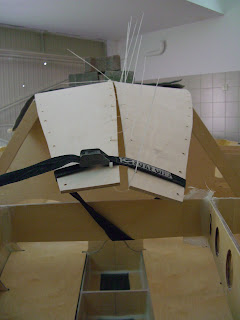The cabin is another enjoyable part to build.
First it is rather large. Second it really changes the appearence of your boat. Finally, it is interesting to see how much bent that plywood is capable of handling !
To be quite honest, it is so much bend and twist that I did it over a few days, letting the plywood rest somehow and assume its final shape without too much stress.
This is how I did it:
First thing I did was do simply lay out all panels to have a sense of the work ahead. It was obvious that some force would be necessary to close that thing alltogether...!
Then I started working the middle panels. That bent is rather simple and straight forward. Moreover, it is not compunded so the plywood does not complain too much. I used hight tech weights (straps and stones !) to get those panels in shape and stitched them progressively from back to front where the tension was much greater. I let them rest overnight.
On the picture on the left, you can see the weights used. The panels are not yet fully stiched but holes were pre-drilled and that worked fine for me.
Once everything was pretty much stiched all together, I was confronted with the challenge of adding a compound curve at the tips of the cabin panels to make them fit flat on top of f53.5 .
A significant gap (below) would have to be closed.....So I once again left everything rest overnight.

The next day I started bending the front of those panels with two pieces of wood (placed above and underneath the tips) and clamps.
10 mns torturing the ply and all panel tips were flat without any cracking sound.
I temporarly screwed them to the two pieces of wood and micro-fileted all panels from above and from below with epoxy thickened with microfibers, without yet removing any zip ties.

What I also did to absorb and hold some of that front panels tension was to add 2 strips of plywood on the underside of the cabin, across all front panel tips.
Those arched strips have pretty much an opposite force to the panels tips and help a lot to hold all of that tension.
The voids that you can see on the picture (top is upside down) are actually from some bad trimming I did. At one point forcing the panels down, I had to trim the panels inside edges because they were overlapping. So I cutted some of what I considered to be excess plywood.. (!?) After, fully flattening the tips, I ended up with gaps between the side panels... :(
This is not so bad though as a large part of this cabin front will be cutted to perfectly fit the boat. The cabin top is indeed a little too long and will be shortened about 2 inches length wise.
In addition whatever gaps leftover can easily be filled with a mixture of epoxy and microfibers. It is a tough putty once it dries !
If I had to do it again, however, I would have started to flatened the tips, then released some of the tips zip ties to avoid the panels to overlap, then kept on flatenning the tips without doing any trimming.

The cabin top looks now really solid. I might just laminate some carbon on those cross-stringers to make them even stronger.







.jpg)


.jpg)